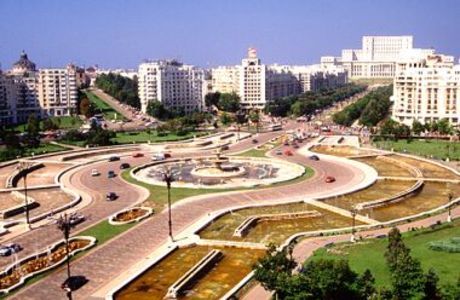Unirii Square Area
Once upon a time, not very long ago, in the 19th century and at the begining of the 20th century, there was a large town with aristocratic avenues and squares designed in European style, where the historic centre held place of pride with its 14th century Old Princely Court and Church, Manuc's Inn, with Lipscani, its picturesque and lively commercial area, with the Metropolitan Church dominating the town from the top of a hillock, with medieval monasteries built by brave Romanian princes and eminent scholars, i.e.Vacaresti, Mihai Voda, Radu Voda, Antim Ivireanul. One-storey houses were built around churches, attesting to the presence of human communities strongly attached to Christian standards and sets of values. One could actually find his or her way in town by the church steeples; their number and variety would left a vivid and lasting impression on travellers' minds.
Town architecture in the 19th century and at the beginning of the 2Oth century was easy to read and understand. Economic growth had led to the outlining of a Neo-Romanian style, mainly derived from the French eclectic style; standing proofs in this respect are Bucharest University, the Romanian Athenaeum, the National Bank, the Savings Bank, the Palace of Justice a.s.o. In the '3Os and '4Os, blocks of flats, alligned on the two sides of the city's large boulevards were quite modern for the Europe of that time; they looked simple, functional and comfortable.
After WW II, Romania became a communist country. Urban planning, including the capital city was supposed to serve the interests of the working class and of the Marxist ideology. To a Bucharest with a diversified architecture (none of its buildings looked alike), with large green areas of parks, gardens and surrounding forests were added suburbs with clusters of concrete, depersonalized, standardized blocks of flats, the so-called "dormitory lodgings" of the '6Os.
Ceausescu's age starting from 1965, his "New Golden Age" with its artificially conceived "new type of humanity", required major changes, including the aspect of Bucharest, whose architecture had to attain the "magnificence" of Romania's communist leader. For Ceausescu, famous for his megalomania, was not pleased with whatever and whoever had built before him. He had to leave his indelible "stamp" on the capital-city of Romania. In the ‘80s, he decided that Unirii Square, whose ground was least exposed to earthquakes, was most appropriate for his plans. This is how one fifth of the city's built central area was bulldozed over night. The hurricane of demolitions would not spare anything. Historic buildings and monuments, among which the Central Military Museum, the Army Printing House, the Army Theatre, the Institute of Sport and Physical Education, the Operetta House, the Brancovan Hospital, St.Friday Church, St.Spiridon Church, Vacaresti Monastery built in Brancovan art style, lots of private houses were actually wiped out. 1O,OOO houses and villas built in the Neoclassic style or the Art Deco were demolished; 4O,OOO people lost their homes, and were forced to move in barely finished blocks of flats, whose facilities were not yet operational. Nobody would even think to appeal for his right to live in his own house.
A new "civic centre" emerged out of smoking ruins. Its design had been inspired by Kim Ir Sen's Northern Korean capital city. Two world despots would exhibit their boundless power by building a town of their own, with large avenues and squares for crowds of "humble" people to applaud, and to worship them. Their absolute power would also need a huge presidential palace, ironically called in Romania "The House of the People", and surrounded by no less "majestic" buildings for the main country's institutions and ministries. Richly decorated artesian wells could not possibly miss from such a pompous setting. The two communist leaders were very much alike except that the tyrant from Phenian was more "humane" whatever he built was on free ground, he did not "offend" history, or human dignity and freedom the way Ceausescu did.
1OO,OOO people brought from all over the country worked hard, and very often with love and professionalism to produce whatever one can identify today with the "civic centre", Ceausescu's most spectacular legacy. Had it not been for his own and his wife's "precious indications", and for their doubtful artistic tastes and bending to surcharged decorations, the whole assembly might have been acceptable, if not even beautiful.
Some Romanians, especially historians, art historians, architects, all those who have been aware of the value of what was lost forever through overall and brutal demolition can still feel the pain attached to this major defeat of human common sense. Other Romanians who were not involved in the process do not seem to be affected by the disharmonious aspect of their city (split now into two anachronic parts covering only 1,5 sq. km old Bucharest and Ceausescu's Bucharest).
Visitors from elsewhere swing between reserve and sheer admiration for whatever grandiose constructions could be produced in a country like Romania, by its own work-force, and with its own row materials. Should Bucharest itself speak out, it would probably evoke the many times it was destroyed by fire, plunder, sword or earthquakes and deplore the one time in its history when it was assaulted, maimed and aggrieved during peace time.
From Bucharest Otopeni Airport, follow direction City Center, pass the Arch of Triumph, then follow Kiseleff Road to Piata Victoriei, take Calea Victoriei, cross River Dambovita and turn left, then – right up to Piata Unirii.




